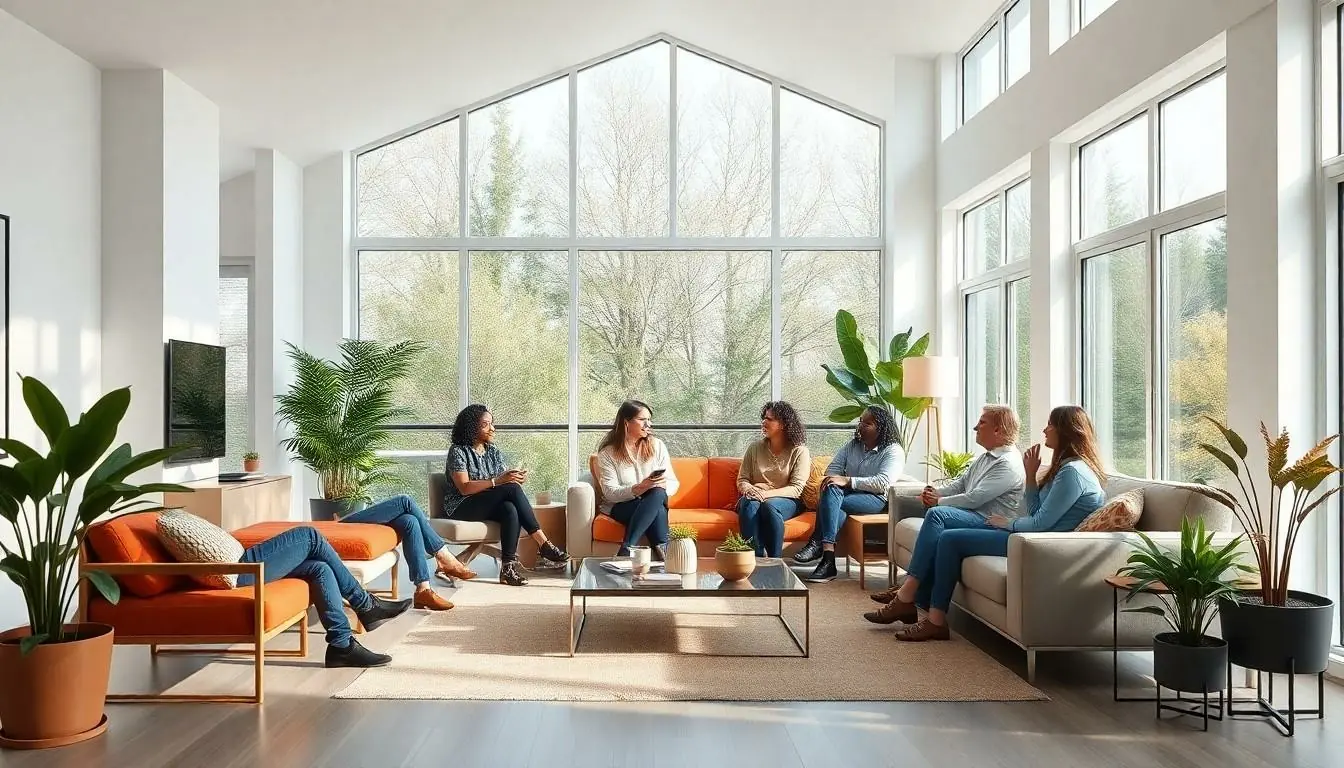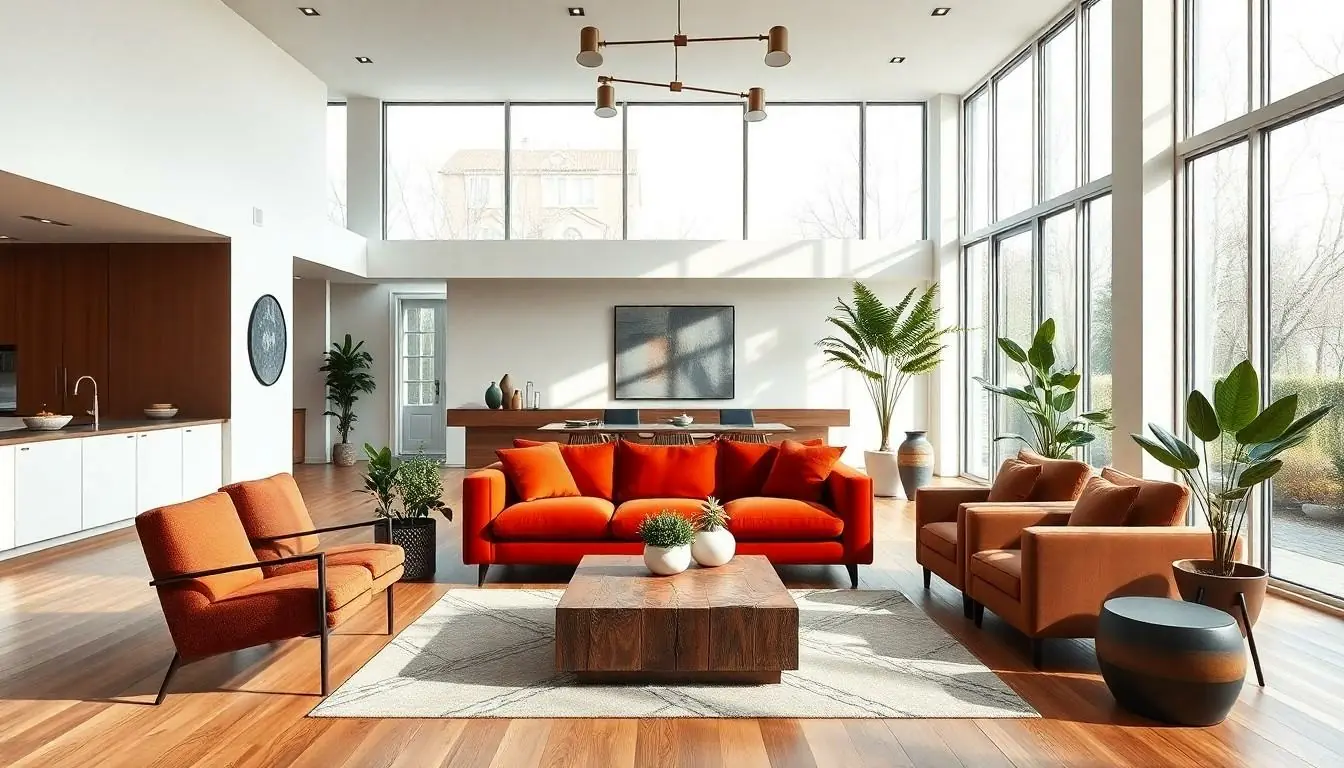In a world where home is more than just a roof over one’s head, modern interior design has become the ultimate playground for creativity. Gone are the days of bland beige walls and mismatched furniture that looks like it survived a yard sale. Today’s designs embrace bold colors, sleek lines, and a dash of personality, making every room a reflection of its inhabitants.
Table of Contents
ToggleOverview of Modern Home Design Interior
Modern home design interior integrates functionality with aesthetic appeal. Designers focus on minimalism, emphasizing open spaces and clean lines. Bold colors often highlight key features, creating striking contrasts.
Textures play a significant role in modern interiors. Combining materials like wood, metal, and glass elevates the visual interest. Lighting fixtures are carefully curated, serving both practical and decorative purposes.
Furniture selection prioritizes comfort without sacrificing style. Pieces are often multifunctional, catering to the demands of contemporary living. Accessories enhance the overall design, balancing simplicity with personality.
Greenery is frequently incorporated, adding life to interior spaces. Plants provide a sense of tranquility and complement the design aesthetic. Sustainability shapes modern choices, leading to eco-friendly materials and practices.
Technology integration becomes essential in home design. Smart home devices streamline daily tasks while enhancing convenience. Designers incorporate these elements seamlessly, ensuring they align with the overall design vision.
The result of these trends leads to spaces that resonate with occupants. Modern interior design reflects individuality while maintaining a cohesive look. Each room tells a story, showcasing personal tastes and lifestyle preferences.
Key Elements of Modern Home Design Interior

Modern home design interior hinges on a few key elements that create functional and stylish spaces. These components blend to produce an engaging atmosphere that resonates with inhabitants.
Open Floor Plans
Open floor plans promote interaction and fluidity among living spaces. Spaces like kitchens, dining areas, and living rooms flow seamlessly into each other. This design choice maximizes usable space and encourages social gatherings. Furniture placement becomes crucial for defining zones within these larger areas. Minimal barriers enhance the room’s visuals and create an airy environment. Additionally, open layouts often incorporate multifunctional furniture that adapts to various needs throughout the day.
Minimalist Aesthetics
Minimalist aesthetics embrace simplicity and functionality. Clean lines and uncluttered spaces characterize this approach, emphasizing what truly matters. This design philosophy utilizes a limited color palette, focusing on neutral shades supplemented by bold accent colors. Items chosen for aesthetics serve practical purposes, contributing to the overall harmony of the space. Each element’s streamlined appearance creates a serene environment. Ultimately, this clarity enhances focus and peace within modern interiors.
Natural Light and Ventilation
Natural light and ventilation establish a welcoming ambiance in modern interiors. Expansive windows and strategically placed openings invite sunlight into spaces. Ample daylight reduces the need for artificial lighting, contributing to energy efficiency. Ventilation plays a vital role in maintaining indoor air quality. The incorporation of natural elements, such as plants, also promotes a healthy atmosphere. Sunlight and fresh air together enhance the overall mood, creating an invigorating home environment.
Popular Styles in Modern Home Design Interior
Modern home design features various popular styles, each with distinct characteristics that cater to different tastes and preferences.
Mid-Century Modern
Mid-century modern design emphasizes simplicity and functionality, showcasing clean lines and organic forms. Iconic furniture pieces, like Eames chairs, incorporate innovative materials paired with vibrant colors. This style integrates seamlessly with nature, often featuring large windows that blur the lines between indoor and outdoor spaces. Geometric patterns and retro accents add a nostalgic charm to interiors. Homes embody an open layout, allowing for fluid movement between spaces while maintaining a cozy atmosphere.
Contemporary Style
Contemporary style continually evolves, reflecting current trends in design. It balances clean, sleek lines with bold colors and textures. Minimalism plays a crucial role, favoring open spaces and an uncluttered aesthetic. Sustainable materials become essential, aligning with eco-conscious living. Accessories and artwork often feature prominently, providing personalization without compromising simplicity. Functionality and form come together in furniture choices that serve multiple purposes, enhancing everyday living while making a striking visual statement.
Industrial Design
Industrial design captures an urban, raw aesthetic, drawing inspiration from warehouses and factories. Exposed brick, concrete elements, and metal fixtures create a rugged yet refined look. This style embraces an open floor plan that fosters openness and versatility, allowing spaces to serve various functions. Vintage furnishings blend effortlessly with modern pieces, establishing an eclectic mix. Lighting fixtures, often large and statement-making, emphasize the industrial vibe while enhancing functionality. Natural textures and reclaimed materials amplify warmth and character within the space.
Color Palettes and Materials
Color palettes and materials significantly shape modern home design. They create a sense of harmony and visual interest, elevating the overall aesthetic.
Neutral Tones
Neutral tones form the foundation of many modern interiors. Shades like beige, gray, and taupe offer versatility and allow for bold accent colors. These palettes not only create a calming atmosphere but also serve as a backdrop for art and furnishings. Textures play a key role. Incorporating materials such as soft textiles and smooth metals enhances the engagement with neutral tones. Spaces often use these colors to promote open, airy feelings and make rooms appear larger. Balancing these tones with different finishes—including matte and glossy—adds depth to interiors.
Sustainable Materials
Sustainable materials prioritize environmental impact in modern design. Choices such as reclaimed wood, bamboo, and recycled metals reduce carbon footprints and promote eco-friendly living. They contribute to a unique character, often featuring natural imperfections that tell a story. Many designers favor low-VOC paints and sustainable fabrics to enhance indoor air quality. Use of these materials reflects a commitment to sustainability without sacrificing style. Combining them with contemporary design elements creates a cohesive vision that resonates with eco-conscious homeowners. Incorporating plants and greenery amplifies the natural aesthetic, fostering a connection between indoor and outdoor spaces.
Modern home design is a vibrant fusion of creativity and functionality that transforms living spaces into personal reflections. By embracing minimalist aesthetics and bold colors, it creates environments that are both inviting and unique.
The integration of sustainable materials and smart technology enhances convenience while promoting eco-friendly living. Each design choice contributes to a cohesive look that tells a story about the inhabitants’ lifestyle and preferences.
Ultimately, modern interior design encourages individuality while fostering a sense of tranquility and connection to the surrounding environment. As trends continue to evolve, the essence of modern design remains rooted in enhancing everyday living through thoughtful and innovative approaches.






